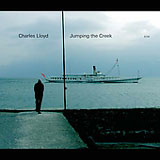Home » Jazz Articles » Album Review » Charles Lloyd Quartet: Jumping the Creek
Charles Lloyd Quartet: Jumping the Creek
One of the best full quartet tracks found on Jumping the Creek opens the disc, a cover of Jacques Brel's "Ne me quitte pas." It begins tamely enough, with Lloyd playing the pleading refrain over and over again (Geri Allen's piano is a minor masterpiece of mood-making, and here as elsewhere, she is ably supported by Eric Harland's quietly radiating cymbals and Robert Hurst's clear, assertive bass), but the piece slowly builds to a frantic, aching, threatening state. Before the emotionally spent closing head, Lloyd seems to be shrieking, screaming, "Don't leave me! Don't you dare leave me!"
"Ken Katta Ma Om (Bright Sun Upon You)" is more or less two conjoined duo pieces: first free-flowing Lloyd and locomotive Harland, then erratic Allen and an increasingly restless Harland. The trio finally comes together to wrap up the tune and fade out.
Using these different group permutations, Lloyd and his quartet experiment with motion. Allen's absence on "Canon Perdido" makes for a sleek, streamlined song, darting ever forward as though physically compelled to do so; whereas her lush, sweeping piano, combined with Harland's building-without-climaxing percussion, makes "Angel Oak Revisited" sound like one long intro, all tension and no release.
"The Sufi's Tears" stands out because it wears its ethnic inspiration on its sleeve rather than integrating small threads into the fabric of a song. Apart from its exotic beauty, however, it is one of the least inspired songs on Jumping the Creek, and along with the distinctly French, Spanish, Inuit, English, and North American-themed tracks throughout, it lends it the feel of Charles Lloyd's Mystical World Tour. But this, too, refers to the "jumping the creek" metaphor, a man leaping back and forth across the oceans to gather and assimilate new musical influences.
If, as Walter Pater said, "All art constantly aspires towards the condition of music," then the music on Lloyd's newest release certainly aspires to something beyond itself. Like fellow reedmen John Coltrane and David S. Ware, Lloyd is grasping and striving toward transcendence. He does not always do so with Coltrane's assurance and grace, or Ware's sense of complete catharsis, but together with the fine quartet assembled here, he has recorded an album that stands as a landmark in his own respectable body of work, as well as the ECM catalogue.
Track Listing
Ne Me Quitte Pas; Ken Matta Ma Om (Bright Sun Upon You); Angel Oak Revisited; Canon Perdido; Jumping the Creek; The Sufi's Tears; Georgia Bright Suite: a. Pythagoras at Jeckyll Island, b. Sweet Georgia Bright; Come Sunday; Both Veils Must Go; Song of the Inuit
Personnel
Charles Lloyd
saxophoneCharles Lloyd- tenor and alto saxophones, taragato; Geri Allen- piano; Robert Hurst- double-bass, Eric Harland- Drums, Percussion
Album information
Title: Jumping The Creek | Year Released: 2005 | Record Label: ECM Records
< Previous
International Festival Musique Actuel...
Next >
Momentum
Comments
About Charles Lloyd
Instrument: Saxophone
Related Articles | Concerts | Albums | Photos | Similar ToTags
For the Love of Jazz
 All About Jazz has been a pillar of jazz since 1995, championing it as an art form and, more importantly, supporting the musicians who create it. Our enduring commitment has made "AAJ" one of the most culturally important websites of its kind, read by hundreds of thousands of fans, musicians and industry figures every month.
All About Jazz has been a pillar of jazz since 1995, championing it as an art form and, more importantly, supporting the musicians who create it. Our enduring commitment has made "AAJ" one of the most culturally important websites of its kind, read by hundreds of thousands of fans, musicians and industry figures every month.




















